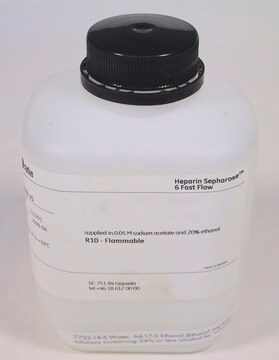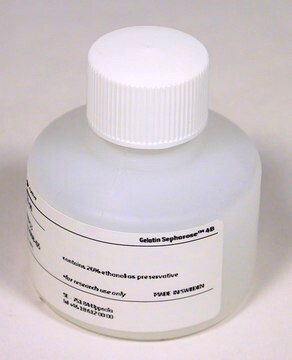H6508
Heparin−Agarose
Type I, saline suspension
Synonym(e):
Heparin beads, Heparin resin
About This Item
Empfohlene Produkte
Biologische Quelle
heparin from Porcine intestinal mucosa
Typ
Type I
Form
saline suspension
Kennzeichnungsgrad
400-1500 μg per mL packed gel (activity approx. 140 USP units per mg)
Methode(n)
affinity chromatography: suitable
Matrix
cross-linked 4% beaded agarose
Matrixaktivierung
cyanogen bromide
Matrixanbindung
amino
Matrix-Spacer
1 atom
Eignung
suitable for chromatography
Lagertemp.
2-8°C
Suchen Sie nach ähnlichen Produkten? Aufrufen Leitfaden zum Produktvergleich
Anwendung
Physikalische Form
Lagerklassenschlüssel
10 - Combustible liquids
WGK
WGK 3
Flammpunkt (°F)
Not applicable
Flammpunkt (°C)
Not applicable
Persönliche Schutzausrüstung
Eyeshields, Gloves, type N95 (US)
Analysenzertifikate (COA)
Suchen Sie nach Analysenzertifikate (COA), indem Sie die Lot-/Chargennummer des Produkts eingeben. Lot- und Chargennummern sind auf dem Produktetikett hinter den Wörtern ‘Lot’ oder ‘Batch’ (Lot oder Charge) zu finden.
Besitzen Sie dieses Produkt bereits?
In der Dokumentenbibliothek finden Sie die Dokumentation zu den Produkten, die Sie kürzlich erworben haben.
Kunden haben sich ebenfalls angesehen
Unser Team von Wissenschaftlern verfügt über Erfahrung in allen Forschungsbereichen einschließlich Life Science, Materialwissenschaften, chemischer Synthese, Chromatographie, Analytik und vielen mehr..
Setzen Sie sich mit dem technischen Dienst in Verbindung.










